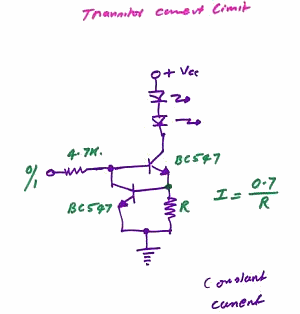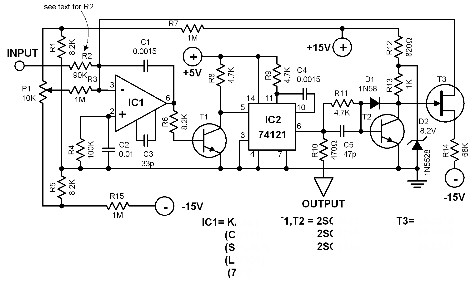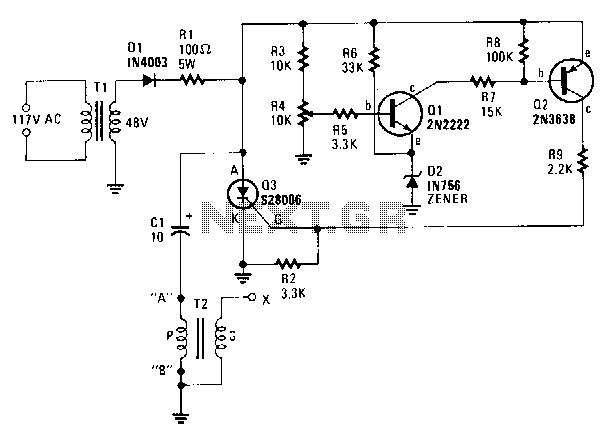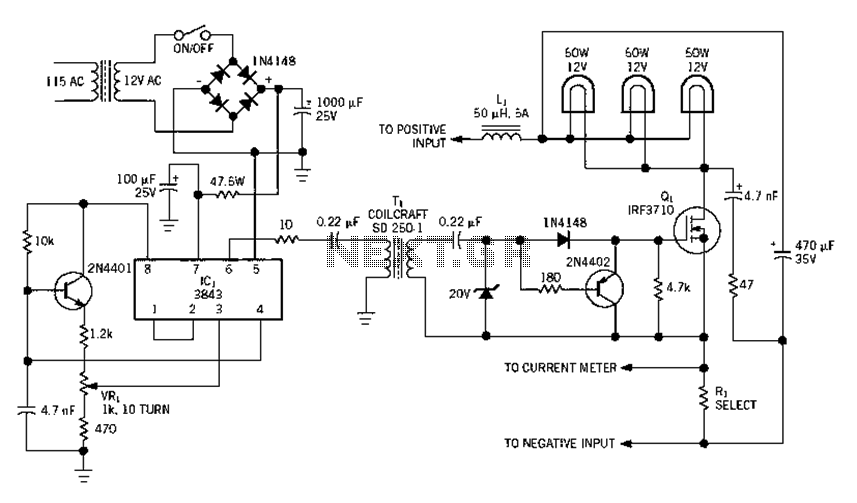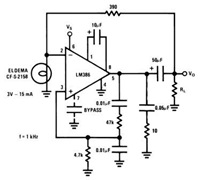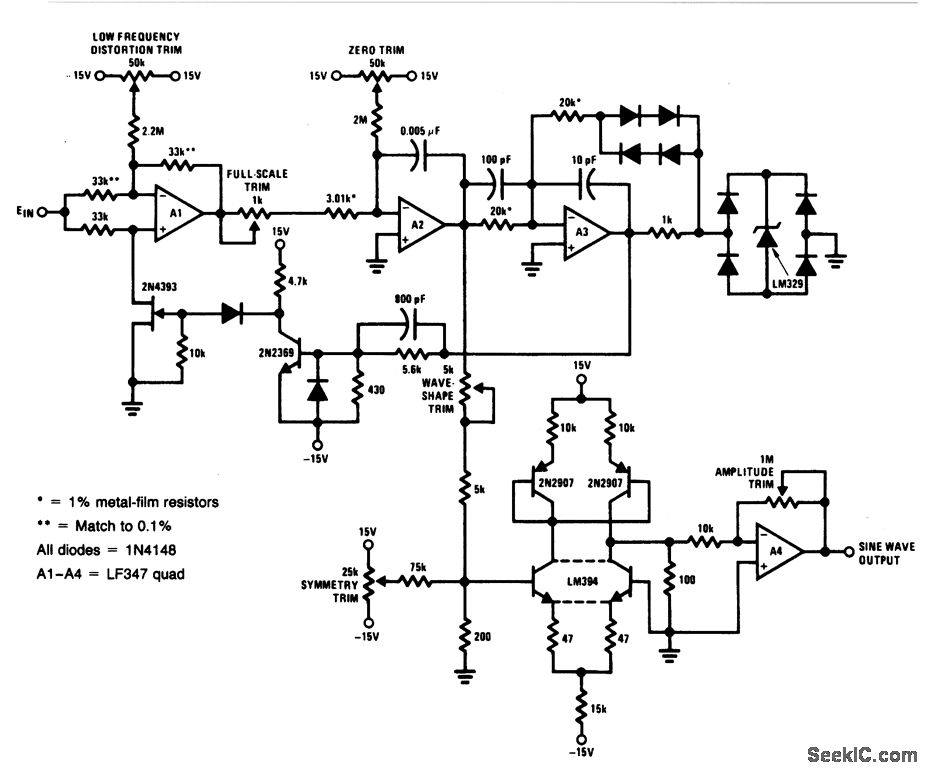
Power Supply Current and Voltage Regulated By LM317 or LM350
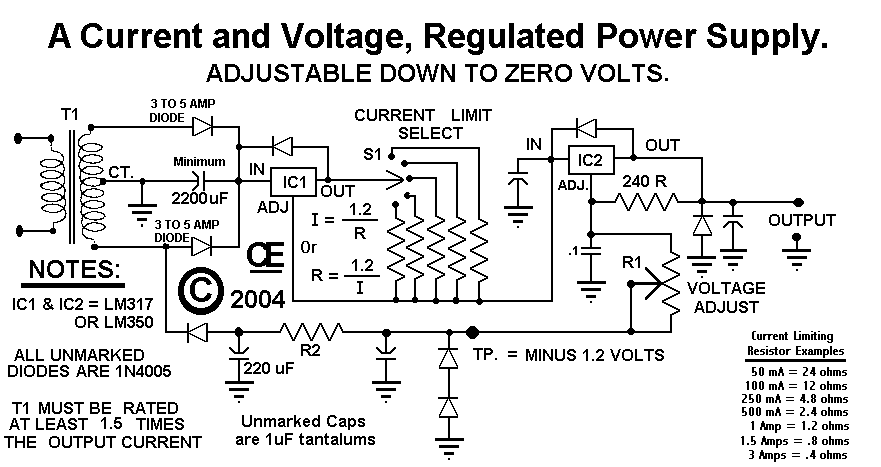
This circuit employs a rotary switch to select various current ranges, as using a potentiometer is not practical for lower resistance and high current ranges. However, a potentiometer can be utilized for lower current ranges, with the lowest switch range potentially being a potentiometer combined with a small series resistor. This allows for adjustment from approximately 10 mA to 500 mA. Fixed resistors are recommended for higher current ranges. It is advisable to construct two of these circuits to facilitate both positive and negative supply voltages when necessary. The circuits can be connected in parallel or series to accommodate higher currents or voltages, as required. The output voltage and current are influenced by the transformer used, as well as the choice of voltage regulator, with options including the LM317 for a maximum of 1.5 amps or the LM350 for a maximum of approximately 3 amps.
This circuit design utilizes a rotary switch to effectively manage current range selection, which is essential in applications requiring precise current control. The rotary switch offers a reliable method to toggle between different resistance settings, optimizing the circuit's performance across various operational conditions.
For the lower current ranges, incorporating a potentiometer allows for fine-tuning of the current output, enhancing the versatility of the circuit. The inclusion of a small series resistor with the potentiometer ensures that the circuit remains stable and prevents excessive current flow that could lead to damage.
In higher current applications, fixed resistors are preferred as they provide consistent and reliable performance without the variability introduced by a potentiometer. The recommendation to construct two circuits allows for dual polarity operation, which is beneficial in many electronic applications where both positive and negative voltages are required.
Connecting the circuits in parallel can increase the total current capacity, while a series configuration can elevate the output voltage, enabling the design to adapt to a wide range of power requirements.
The selection of the transformer is critical, as it determines the input voltage and current available to the circuit. The choice of voltage regulator, such as the LM317 or LM350, further influences the maximum output current. The LM317 is suitable for applications requiring up to 1.5 amps, while the LM350 can handle up to approximately 3 amps, allowing for flexibility depending on the specific needs of the application.
Overall, this circuit provides a robust solution for applications requiring adjustable current ranges, with considerations for safety, stability, and adaptability to various electrical demands.In this circuit I have used a Rotary Switch to select Various Current ranges as a Potentiometer is not very practical for the lower resistance/High Current Ranges. But if you wish to change it to a pot, you can try it. * It is practical to use a pot on the lower current ranges so the lowest switch range could be a pot with a small series resistor.
Allowing for adjustment from say 10 mA to 500 mA . Than use fixed resistors on the higher current ranges. I recommend in making two of these. This will allow for Plus and Minus supply voltages, when needed. They can Also be Paralleled or placed in Series for Higher Currents or Higher Voltages, As is Sometimes Needed. Output Voltage and current depends somewhat on the transformer used, as well as which Regulator used.
You have a choice of an LM317 for 1. 5 amps Max, or an LM350 to give about 3 amps Max. 🔗 External reference
This circuit design utilizes a rotary switch to effectively manage current range selection, which is essential in applications requiring precise current control. The rotary switch offers a reliable method to toggle between different resistance settings, optimizing the circuit's performance across various operational conditions.
For the lower current ranges, incorporating a potentiometer allows for fine-tuning of the current output, enhancing the versatility of the circuit. The inclusion of a small series resistor with the potentiometer ensures that the circuit remains stable and prevents excessive current flow that could lead to damage.
In higher current applications, fixed resistors are preferred as they provide consistent and reliable performance without the variability introduced by a potentiometer. The recommendation to construct two circuits allows for dual polarity operation, which is beneficial in many electronic applications where both positive and negative voltages are required.
Connecting the circuits in parallel can increase the total current capacity, while a series configuration can elevate the output voltage, enabling the design to adapt to a wide range of power requirements.
The selection of the transformer is critical, as it determines the input voltage and current available to the circuit. The choice of voltage regulator, such as the LM317 or LM350, further influences the maximum output current. The LM317 is suitable for applications requiring up to 1.5 amps, while the LM350 can handle up to approximately 3 amps, allowing for flexibility depending on the specific needs of the application.
Overall, this circuit provides a robust solution for applications requiring adjustable current ranges, with considerations for safety, stability, and adaptability to various electrical demands.In this circuit I have used a Rotary Switch to select Various Current ranges as a Potentiometer is not very practical for the lower resistance/High Current Ranges. But if you wish to change it to a pot, you can try it. * It is practical to use a pot on the lower current ranges so the lowest switch range could be a pot with a small series resistor.
Allowing for adjustment from say 10 mA to 500 mA . Than use fixed resistors on the higher current ranges. I recommend in making two of these. This will allow for Plus and Minus supply voltages, when needed. They can Also be Paralleled or placed in Series for Higher Currents or Higher Voltages, As is Sometimes Needed. Output Voltage and current depends somewhat on the transformer used, as well as which Regulator used.
You have a choice of an LM317 for 1. 5 amps Max, or an LM350 to give about 3 amps Max. 🔗 External reference
